Contactless Check-in for Hotels: 2023 Guide + Tools Review
Revolutionary hotels like Toronto’s The Annex are even doing away with the front desk completely, introducing self check-in as part of a tech-forward approach that places guest convenience and satisfaction at its heart.
And this isn’t just a short-term effect of Covid. Contactless and online check-in for hotels was rising in popularity before the pandemic; the crisis just accelerated the existing trend. That’s why, as the world opens up again, contactless is now fast becoming a must-have for your hotel.
That’s because, in addition to the elimination of needless face-to-face interaction that was so necessary at the height of the crisis, it also enables hotels to:
- Operate a lean model and save costs with fewer staff per unit
- Escape the worst of the current labor shortage
- Demonstrate your innovation, modernity, and fresh thinking
- Prove your commitment to improving and prioritizing your guests’ experience
But it can be complicated to understand what you need, even if you’re relatively tech-savvy (and especially if you’re not!), you’re bound to have questions about whether hotel automation will work for your business.
Every platform is slightly different, and each promises to be the best solution for your hotel, how do you figure out the real advantages and disadvantages, the potential pitfalls, and whether a given tool is right for your business?
We get it.
That’s why in this article, we’ve evaluated some of the biggest contactless check-in solutions on the market today, and listed the biggest things to know and watch out for before you make the switch (which is much simpler and cheaper than you might think).
Read on for:
- A summary of what the contactless check-in process is, and why you’re right to be looking for solutions
- The benefits of contactless check-in, and how it will help your business
- The possible pitfalls and need-to-knows, so you can make the switch with ease
- How to implement contactless, step-by-step
- A list of some of the best tools on the market today, so you can compare and contrast, and make the choice that’s right for you
Want an contactless check-in tool that’s smooth and flexible?
What is contactless check-in?
Contactless check-in enables hotel guests to arrive and check-in to their room without needing to pick up a room key (otherwise known as hotel keyless entry), visit a check-in desk, or otherwise meet someone face-to-face to access. It is contactless in that there is no contact with staff and no need for a physical key.
It is usually done by sending the guest all the information they need to access their room ahead of time, via email, text, smartphone browser, or app, using smart hotel door locks.
Some systems require a smartphone app to check in and may need a front desk or staff member as backup, but truly contactless check-in systems enable guests to enter even without a phone or app, using a keycode and a smart lock and do not need a front desk at all.
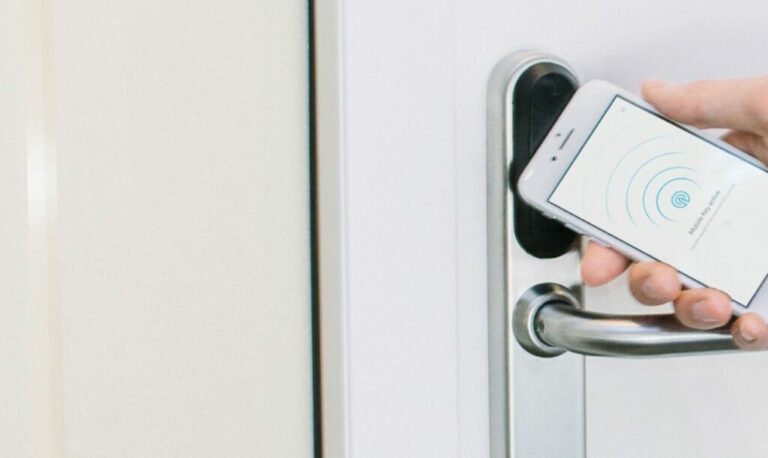
Credit: Salto.com
Benefits of contactless check-in
If you’ve never used hotel check-in automation before, and you’re wondering if it’s right for you and your hotel, it’s worth considering the many benefits of the technology, and how it can work for you no matter your hotel style or technological know-how.
Here’s how contactless helps your hotel:
- It enables staff to become more efficient. Free your staff from behind the front desk and enable them to be mobile, getting more done to help guests and run your hotel, in less time with less stress.
- It saves money on traditional keys and keycards. No need to replace lost, stolen, or deactivated keycards, saving money, time, and plastic.
- It’s safer and more secure. Digital contactless technology means you can change access codes with each new guest, and there are no keys to copy or steal. You can also implement occupancy monitoring devices, to prevent destructive parties and unauthorized guests.
- It saves admin time and hassle. Smart devices, including contactless smart locks, connect everything to your usual PMS, meaning less manual data entry for staff.
- It reduces ‘transactional’ guest interactions. There’s no more need for staff to waste guests’ time awkwardly collecting ID and swiping credit cards while they wait in line.
- It lets staff focus on offering great experiences. Less admin for staff means they can focus on guest experience, such as sending a personalized welcome message or organizing great trips out, rather than boring back-end logistics.
- It hugely improves guest arrival and first impressions. Guests can arrive at any time after check-in without having to wait around at a front desk or have an awkward face-to-face interaction to get their keys. They can head straight to their room, reducing stress in case of delays or changing travel plans.
- It improves guest communication. Guests can still communicate with you and your team digitally on their phones, giving them easy access to help and service at all times.
- It helps boost revenue. Smart technology can seamlessly offer the option for upsells such as extended stays or in-room sales.
- It saves energy. Using smart technology to automatically turn down the heat or turn off the lights when needed can save your business up to 30% in bill costs per year, and help the environment—a must for eco-friendly hotels.
What to know before you go contactless
Going contactless can seem daunting, especially if you haven’t implemented the system before.
But it’s important to realize that going contactless doesn’t mean switching to a faceless, clinical system. It’s actually the opposite.
Here are our biggest need-to-knows and questions we recommend you ask first, so you can make the switch to smart with ease, and use tech to help (not hinder) your hotel.
Consider:
- The type of property you have is important. Are you a boutique hotel? A multi-unit apartment condo? A traditional hotel? What is your goal for contactless—is it to reduce costs? Have fewer staff? Go remote? Changing the way you welcome guests?
- The biggest barrier to entry is upgrading your locks. Choose ones that will work best for your doors and guests (Keypads? Smartphone access?)
- Decide whether you want to do away with the front desk completely, or go for a reduced or hybrid model. True contactless doesn’t need a front desk, but some guests may expect it as a backup at first.
- Seriously consider getting experts involved. This will mean you skip needless stepping stones to true contactless—such as kiosks—which will feel outdated in just a few years. Can you consult an expert and go straight for the real thing?
- Are you willing to bring in experts and a team who can help every step of the way? With access a crucial part of your business (without it, guests can’t get in!); cost shouldn’t be the most important factor. Operto sees customers as partners and ensures that your hotel and staff have help to implement and run the system successfully every step of the way.
- Make sure you have a “digital champion” internally and externally. Appointing someone who is going to help transition your team to the new system. With outside help, you don’t have to be an overnight expert in digital systems, and you and your team can learn as you go.
A major point to remember is that the switch won’t happen overnight. Making the change to contactless and smart is a process.
This table helps to explain how the system can slowly but surely replace everything you might currently rely on a reception desk to do:
Managing online and phone reservations
- Connecting PMS with your OTA or booking engine, and linking it to your contactless platform, such as Operto, to begin the welcome and arrival process
- Connecting with PMS to pull guest data and information to confirm check-in by email
Collecting guest data and ID
- Digitally collected ahead of the stay from the point of booking and saved in PMS
Taking damage deposits
- Taken digitally at the same time as booking ahead of the stay
Handing last-minute or walk-in bookings
- Online booking available at any time via OTA or website
Helping guests with parking information
- Sending all important info ahead of time
Taking payment for bookings
- Taking payment online
Showing guests around
- All welcome information sent digitally by email or SMS
Informing guests of events and deals
- Automated emails timed to coincide with check-in and check-out
Arranging transport and concierge services such as restaurant booking and taxis
- Digital guest communication via smartphone portals connected with PMS
Storing luggage
- Digital guest communication with staff, who are freed up to help with this as they are not stuck behind a desk
Fixing faulty keys or keycards
- Not needed as no more keys or keycards used
Taking payment for in-room incidentals
- Payment taken digitally with a guest portal making it easier to make purchases during stay
Dealing with reported damage or maintenance
- Guest communication via email or SMS
- Integration with smart noise monitoring devices such as NoiseAware
- Via the same portal as check-in, smart lock automatically locks and changes keycode on check out
- Housekeeping coordinated via the digital platform, can see at a glance when cleaners and maintenance staff needed
- Keycodes change with each guest, smart locks only open to authorized people with working keycodes
- Automated emails timed to coincide with check-out
- Automated emails timed to coincide with check-out and days elapsed since their last stay, PMS data pulled in, e.g. for “birthday deals”
How hotels can implement contactless check-in: 5 easy steps
It’s one thing to decide that contactless check-in will work for you. But it’s another entirely to actually get started.
We recommend that you begin with the following questions and setup:
- Step 1. Do you have a plan and strategy in place for your online travel agencies (OTAs) and property management system (PMS)? How will they connect to your contactless system?
- Step 2. How do you want your guests to interact with your hotel? Do you want to remove the front desk entirely? Or just reduce it? Do you want guests to need their smartphones, or not?
- Step 3. Sort out access first. The first step is to get locks that enable contactless installation, such as a smartphone mobile key or keypad access. Once that works smoothly, you can roll the next piece out.
- Step 4. Start changing the way you message guests. Make sure they know that they will receive a PIN code/keypad code ahead of arrival, and check-in that way.
- Step 5. Start to dissolve your front desk and gradually replace tasks with smart tech (see the table above). If replacing your front desk entirely is part of your plans, then you can begin to transition towards that once access and guest communication are in place.
Overall, this will free up front desk staff to provide a better guest experience or allow them to prioritize guest satisfaction from day one. That’s just one of the reasons why many new hotels now open without a front desk at all.
Contactless check-in software for hotels
So you’re still reading, and you’re interested to see if contactless could work for you. Excellent.
But where to start? With so many contactless tools on the market today, it can be tough to know which are reliable or will work best for your hotel and your existing hotel management software.
That’s why we’ve listed some of the best software solutions available now, to help you sort the best from the rest.
Operto
Operto is the full package, with a range of robust features tailored to hotel operations.
Going far beyond simple contactless access, it offers a true “hands-off” experience for the hotelier and has integration with a wide range of PMSs and smart devices.
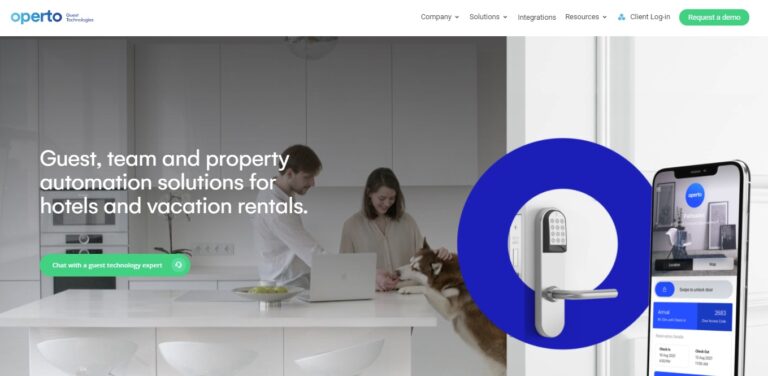
Features
- Truly contactless. Sends unlock codes to the guest room door, as well as any common spaces they need to access during their stay, and gives the guest an individual code so only they can access the room.
- No need for a mobile device to enter, or a front desk as a backup.
- Unique guest portals allow everyone to oversee the entirety of their operations or stay within an intuitive, well-designed platform. The portals are fully customized to the client’s brand and require no custom development work.
- No separate mobile app is needed; a major advantage for guests who might not have signal or data, or who are loath to download another app.
- Works with a range of robust smart locks, including Salto and Yale.
Integrations
- Wide range of PMSs including Mews and Cloudbeds, to pull reservations data from arriving guests automatically.
- Wide range of smart devices, including the Ecobee thermostat and NoiseAware occupancy and noise monitoring, which speak to each other seamlessly.
Mews self-service kiosk
A self check-in kiosk solution that some describe as a stepping stone to truly contactless. Replaces front desk hotel staff by enabling guests to walk in and self-service check-in automatically, reducing waiting times and face-to-face interaction.
Features
- Set up using a QR code.
- Enables guests to use their reservation number no matter how they made the booking.
- Take payment through the kiosk.
- Enable guests to check-out via the kiosk too.
Integrations
- Mews Terminal integration, to enable payments and PMS capability.
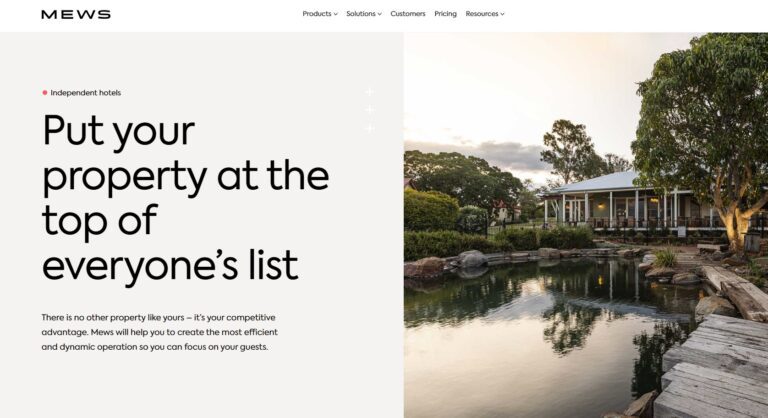
Credit: mews.com
OpenKey
OpenKey is one of the best-known specialists in simple, keyless, digital room access for hotels (learn more and see the best OpenKey alternatives here).
Features
- Designed specifically for hotels (as opposed to short-term rentals).
- Offers both hardware and software specially designed to make hotel keyless, digital access as easy as possible.
- Mobile key software is easy for guests to use but requires a smartphone app to be downloaded.
Integrations
- PMS integrations offer automated smartphone access via its “digital key” system, which also enables guests to view the hotel’s amenities.
- Purely access-focused, meaning it does not connect to any other smart devices or wider ecosystems.
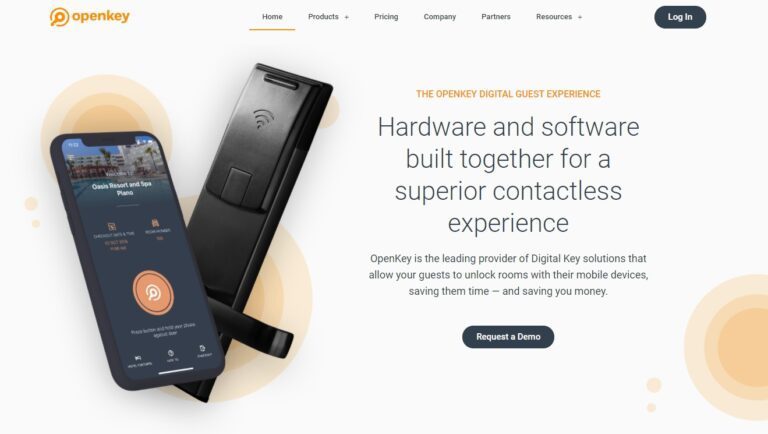
Credit: Openkey.co
Salto
Salto is widely known and prized for its robust, varied, and award-winning access control systems.
Features
- Offers a wide range of access options, specially designed for the hospitality industry.
- Access can be set up via a range of options—including keycodes and smartphones.
- Makes its own locks.
Integrations
- Integrates with major PMSs.
- Access control systems enable hospitality managers to oversee all of their spaces remotely and at a glance.
- Operto integrates with Salto for an even smarter integration with your PMS and all smart devices. Find out more about our integration with Salto here.
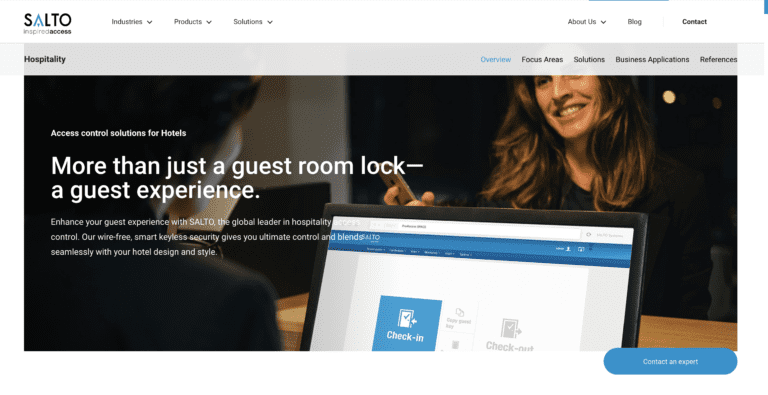
Credit: Hospitality.SaltoSystems.com
RemoteLock
RemoteLock is an access solution designed for multifamily apartments and short-term vacation rental hosts.
Features
- Works with a range of locks, and enables keyless, contactless entry to spaces.
- Mainly focuses on keyless access rather than enabling smart property automation.
- Also produces its own locks.
Integrations
- Has some functionality designed for short-term stays, and integrates with major PMSs and OTAs, enabling automatic sending of key information to guests.
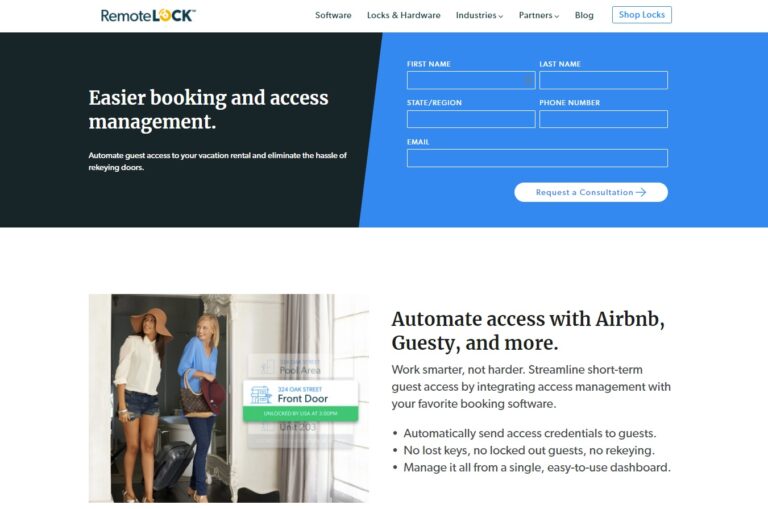
Credit: remotelock.com
Assa Abloy
As one of the world’s oldest lock companies, Assa Abloy makes one of the most established hotel access control solutions and is primarily suited to mid-to-large hotels and chains.Features
- Provides electronic locks and digital keys, but with a complete focus on hotels and similar spaces.
- An access control system with their own hardware for every conceivable access point—including in-room safes, staff safety systems, minibars, and keycard options.
- Uses its own hardware.
Integrations
- Offers mobile key options through a basic app with no integrations or automation. Can be connected to custom-built interfaces with your hotel’s existing systems (making it especially good for hotels that have the resources or existing set-up to implement it).
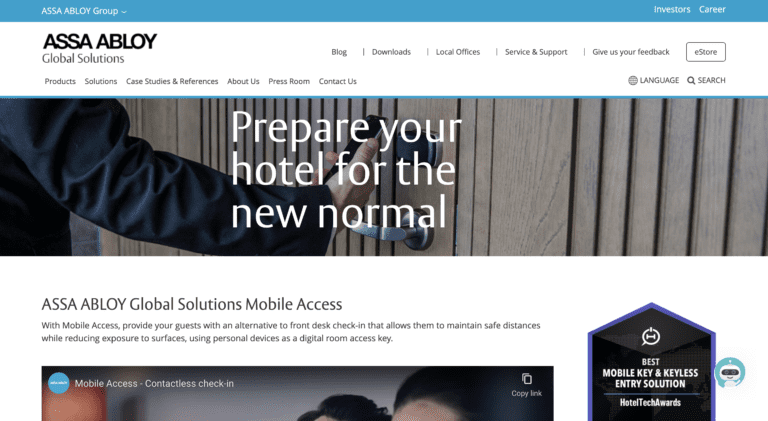
Go contactless: Your next action steps
Now you know what contactless is, why it’s so necessary for your hotel, how to implement it, and what tools are out there, we recommend the following steps to get started ASAP.
- Schedule a demo. Pick 1-2 tools you think will work best for you, and ask the right questions about what you’re actually buying before you make the leap.
- Communicate the changes to your team. Ensure they understand how this will make their life easier, but that there will be a learning curve and some training at first.
- Ensure that the solution you choose will help you implement and operate the system from start to finish. This includes finding a platform that will help you install, operate and maintain the hardware and software, on top of ongoing support.
Contactless check-in: Finding the right solution for your hotel
Depending on your business needs, we reckon that any of these tools listed could be a good choice. While OpenKey specializes in smartphone access, and Salto has world-renowned smart locks, Assa Abloy’s system is particularly well-suited to larger hotels.
Operto is specially designed to provide a robust and reliable contactless check-in solution for hotels, and more besides, with a truly contactless, seamless check-in system that enables great guest messaging, smart device control, and a wide range of PMS integration.
At Operto, we know it can be a challenge to find a remote digital automation and contactless check-in solution that works for you. But in today’s modern, hyper-connected age, with guests who positively expect to have that level of on-demand, digital and personalized control—it’s no longer a nice-to-have. It’s crucial.
That’s why we work with our clients not simply as customers, but as partners, to make the changeover as seamless as possible.
We’re confident that if you want to, you’ll find a contactless check-in solution that’s right for you—and if that happens to be us, we can help you make the switch with ease.
More Articles
Want an operations tool that’s smooth and flexible?
